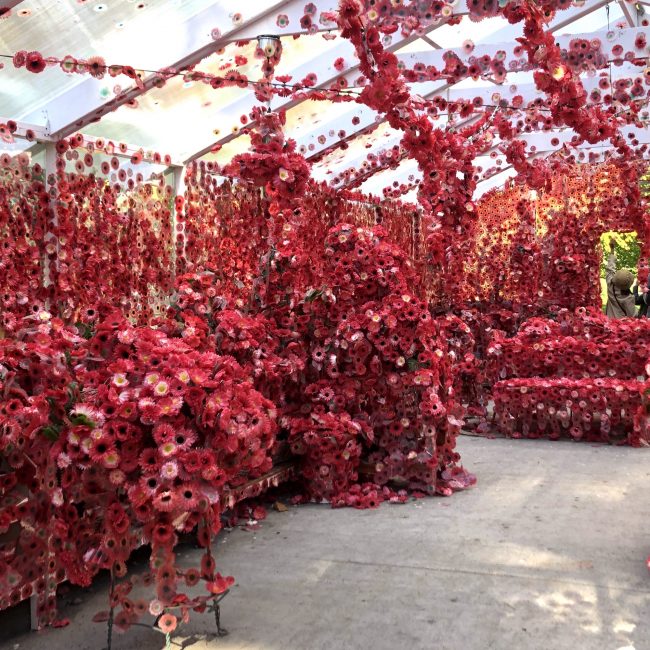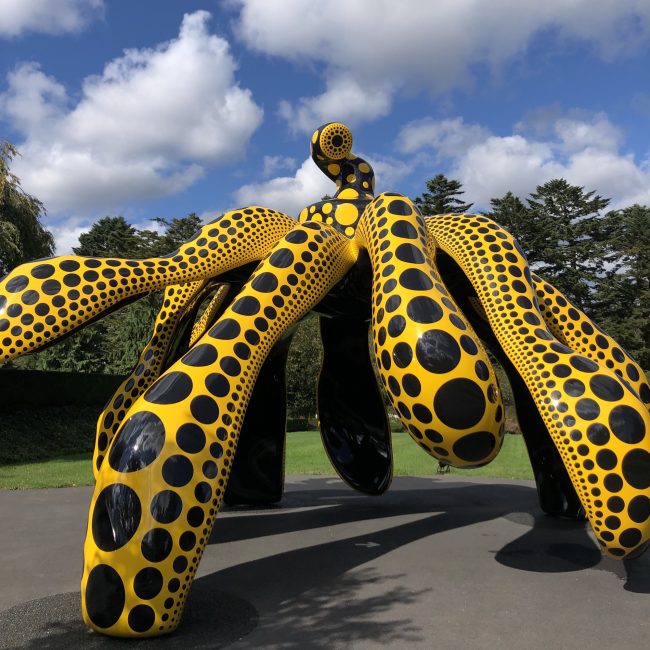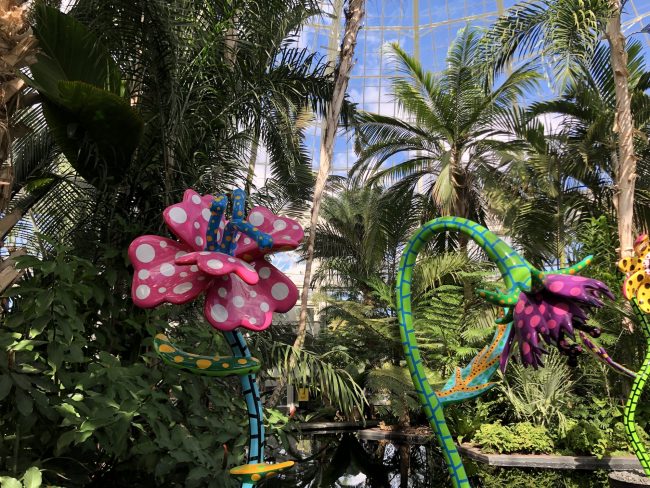How Kusama embodied Haraway
Posted on October 29, 2021On a sunny weekend, every entrance of the Bronx’s New York Botanical Garden(NYBG) is full of people in line. All of them came to see the exhibition of Yayoi Kusama, one of the most famous artists in the world who turned 92 this year. In the garden full of greenery, Kusama’s brightly colored works greet people here and there. The harmony of nature and artifacts full of dots arranged in a perfect scale with a particular pattern is unfamiliar and subtle. Looking at artificial works of art in nature, I was able to visualize Haraway’s discourse in Staying with the Trouble, asserting Chthulucence beyond the Anthropocene, which is about rethinking human exceptionalism and the connection between organisms. Although art-making might be the most humanistic behavior/practice that can be harmful to the environment, the day at the NYBG helps me realize the power of art, suggesting another way to think about complex ideas in the world.

Flower Obsession, 2021, The New York Botanical Garden Photo: J. Lee
“Flower Obsession,” also called the obliteration greenhouse, is an audience-participating work. Before entering the greenhouse, the audience will receive one plastic gerbera flower with a sticker on its stem. In the greenhouse, they confront reproduced unnatural human creations such as various furniture and farming utensils. The audience freely attaches a flower to the surface to create a work together. It can be said to be a work of sympoiesis, which means “making-with.” As flowers increase one by one, the more the audience collectively produces the artwork, the more the identity of the space is erased, and it turns into an alien space covered with red flowers. This provocative work is evolutionary and has the potential for surprising change, as Katie King described sympoiesis. It was amazing to see how people placed their flower and made a connection to the other.

Dancing Pumpkin, 2020, The New York Botanical Garden Photo: J. Lee
“Dancing Pumpkin,” newly created for this exhibition, shows off its massive presence on the lawn in front of the conservatory. The shape of turbulently dancing pumpkins surrounded by dots looks like the tentacles of an octopus. Haraway describes the Chthulucence as the tentacular way that humans and non-humans are inter-connected in the world. We can feel this walking through the pumpkin, appreciating the work. The audience looks up at the inner side of the pumpkin as they pass through the space between the huge tentacles, situated under the artifact organism. Through the natural flow of being inside and outside of this work, Kusama forces us to see the inter-connectedness and shape response-abilities.

My Soul Blooms Forever, 2019, The New York Botanical Garden Photo: J. Lee
“My Soul Blooms Forever” greets the audience at Palm of the World Gallery in the conservatory. Giant palm trees nearly reach the ceiling. If you raise your head and appreciate the size of the trees and leaves, you can feel the magnificent vitality of nature. In the middle of that, stainless steel flower-shaped sculptures are standing, wearing over-the-top colors and dots, and replicating nature’s shape. How and where this work is situated amplified the contrast between things and living beings and made me realize the distinction between them and the awkwardness of artificial figures.
The lively childlike colors of pumpkins and flowers found throughout the garden are like scenes from children’s books. Throughout her entire life, Kusama has been practicing speculative fabulation (SF)-storytelling-that Haraway refers to. Kusama’s work is a cycle of production and reproduction that tries to return to nature through an organic form of artificial object inspired by nature. As Haraway questioned in Staying with the Trouble, “Kusama: Cosmic Nature” helped me rethink our relationship to nature in the multispecies world:
What happens when human exceptionalism and bounded individualism, those old saws of Western philosophy and political economics, become unthinkable in the best sciences, whether natural or social? Seriously unthinkable: not available to think with. … What happens when organisms plus environments can hardly be remembered for the same reasons that even Western-indebted people can no longer figure themselves as individuals and societies of individuals in human only histories?
References:
- Kusama: Cosmic Nature. https://www.nybg.org/event/kusama/
- Haraway, Donna. Staying With the Trouble: Making Kin in the Chthulucene. 2016.